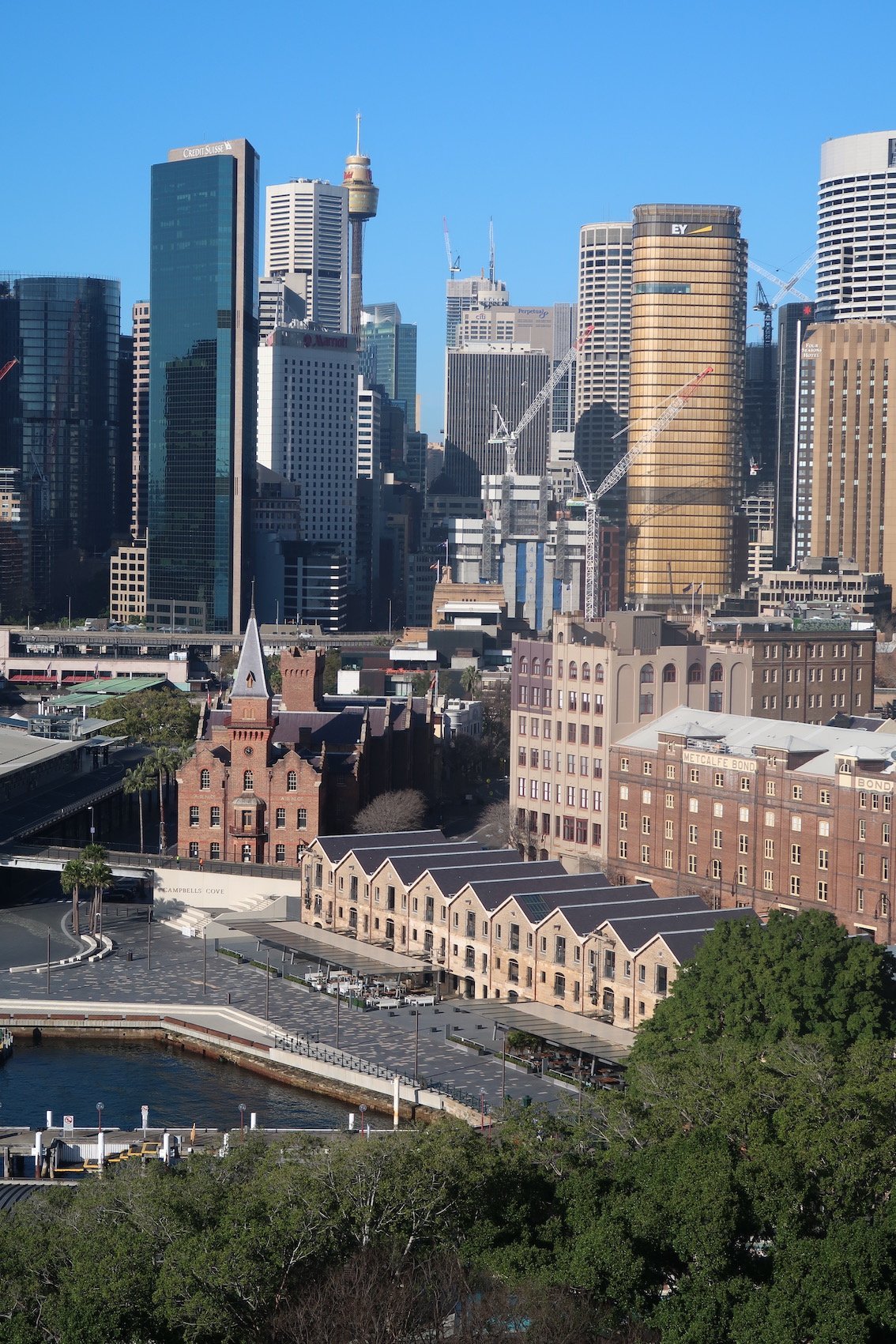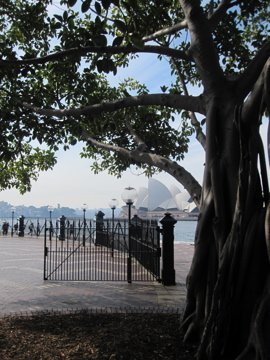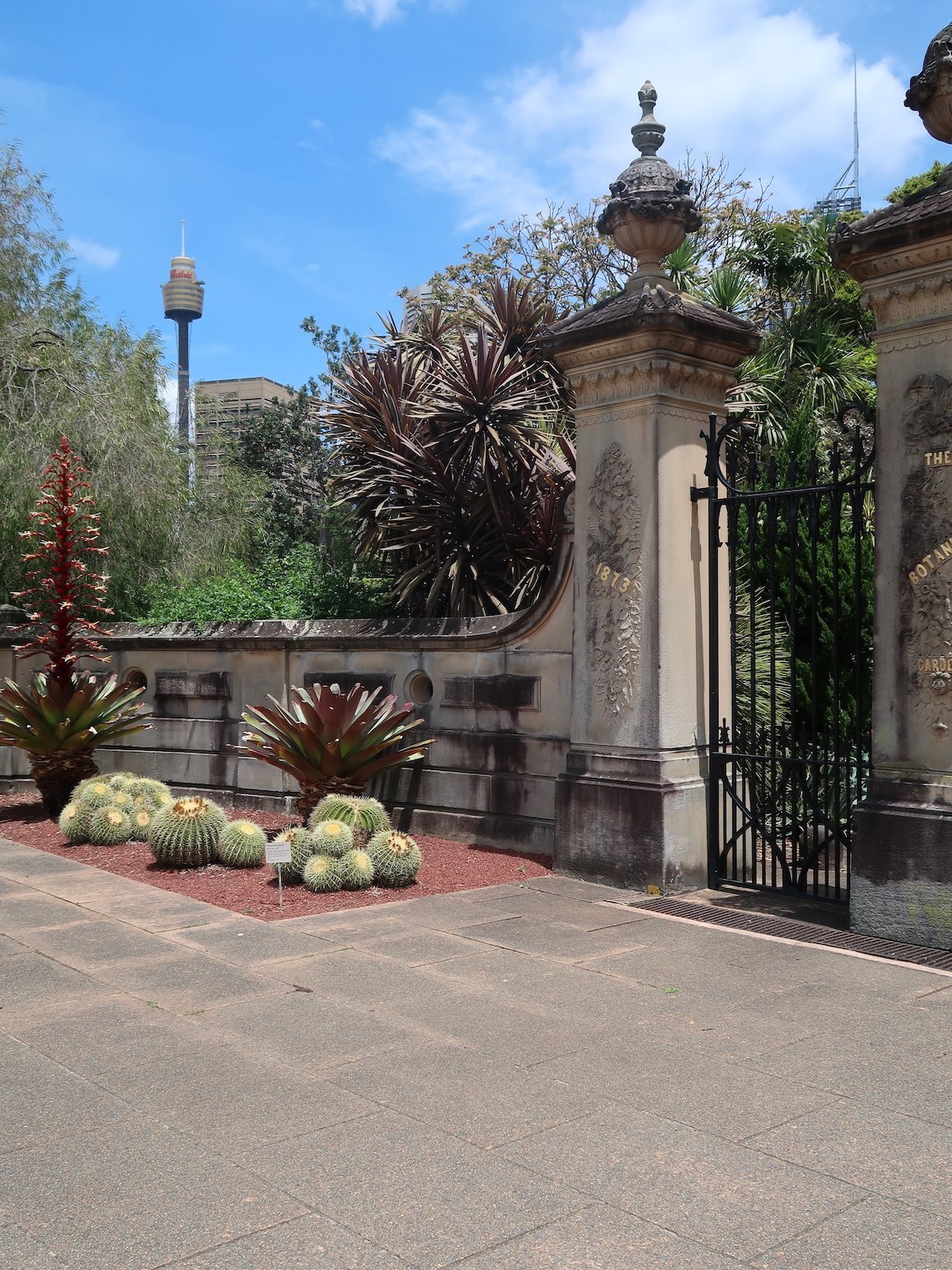Milsons Point to Mrs Macquarie’s Chair
This is a loop walk and it can be done in a couple of hours. But you’ll get a lot more out of it if you take your time.
There is so much to see en route, not the least being the iconic Harbour Bridge and Opera House. The path takes you around the harbour, past galleries and through gardens, and you’ll find plenty of places to dine or picnic along the way.
The walk begins at the steps of the Harbour Bridge in Milsons Point. Milsons Point Station, on the North Shore and Northern line, is nearby.
The Harbour Bridge
Climb the stairs and follow the crowd to cross one of the most beautiful harbours in the world. Below you are ferries, yachts, and the glistening sails of the Sydney Opera House. Above you soars the world’s largest steel arch bridge, totalling 1,149 metres and comprised of over 550,000 tonnes of steel.
The bridge is nicknamed ‘The Coathanger’, for obvious reasons. It first opened in 1932 after eight years in the making. Its height makes it visible in many far-flung parts of Sydney and it acts as the main stage New Years Eve fireworks each year.
Look up at the top and you’re sure to see groups of overall-clad figures walking along the upper-most arch. Since 1998, Bridge Climb Sydney has been escorting people over the arch of the bridge. To date, more than four million people have done the climb. If you’ve yet to try it, I recommend you give it a go. I loved the whole experience and I’m scared of heights! The views can not be beaten. and you feel like you’re on top of the world.
At the bridge’s end the path loops slightly to the left and to a set of steps that will take you down to Cumberland Street. Cross Cumberland St and take the Argyle steps down to Argyle St in the heart of The Rocks.
The Rocks
The Rocks (Tallawoladah) bears many traces of Sydney’s colonial history and is home to some of its earliest buildings.
The lanes and alleyways, are fun to explore with some great bars and cafes all, it seems, competing to be the most instagrammable. The Rocks Markets operates from Friday to Sunday offering local food and fashion, handcrafted jewellery, and objects by independent artists and artisans.
If you want to learn more about the Rocks , the Visitors Centre on Argyle St is a good place to start, or drop into the Rocks Discovery Museum in Kendall Lane. The Rocks Walking Tours company offers tours daily.
At the edge of The Rocks, at the harbour end of Argyle St sits Sydney's premiere contemporary art galley, the MCA. If you have the time, it’s certainly worth a look. Entry is free and the cafe on level four has fabulous views.
Circular Quay
Turn right here at the MCA and follow the path around to the Circular Quay ferry wharves. Above you is the train station and the Cahill Expressway which you’ll walk along on the way back.
Circular Quay has many moods. On rainy days everything looks grey; the wind whips umbrellas around and commuters bang into each other rushing for ferries. But on sunny days, the harbour is glistening and the quay has a holiday vibe and every second person is carrying an ice cream.
Circular Quay is a tourist gateway taking travellers to places like Taronga Zoo, Manly Beach and Rose Bay on board the iconic Sydney ferries.
Passing the ferry wharves, follow the curve of the Quay around to the left and on to the Opera House and gardens.
The Opera House
The Opera House sits on Bennelong Point on the Eastern side of the Quay. Its unique shape and distinctive design make it one of the world’s most recognised buildings and one of Sydney’s most frequented tourist destinations.
Designed by Danish architect, Jørn Utzon, The Opera House first opened in 1973, filling a gap in the cultural life of the city. Since its opening it has played host to everything from operas, ballets, symphonies and theatre, to rock concerts, musicals, drama and children’s concerts.
Take the time to wander around and up and down to get some appreciation of the scale and intricacies of the design. (Keep a look out for Benny the fur seal who often takes a rest stop on harbour front steps.)
If you want to experience the House in action check out whats on at the Box Office or book a place on one of the themed guided tours that take place daily.
To Mrs Macquaries Chair
Access to Mrs Macquaries Chair is via a walkway at the edge of the Royal Botanic Gardens. Enter via Queen Elizabeth II Gate, at the foot of the Opera House.
You could easily spend a whole day in these gardens, there is so much to see. Just on the edge here for example are magnificent Moreton Bay figs, at least one of which is more than 150 years old.
For now though we’re just going to skirt the edge, enjoying the fabulous views and scenery and we’ll explore the gardens later on our loop back.
This walkway continues around the point through Turing Gate to Mrs Macquaries Chair. In the summertime, open air cinema and operas are held here and at these times access is blocked. If this is the case, you’ll have to exit the gardens at Victoria Lodge Gate and take the upper path (past a toilet block and bubbler) and back down to Yurong Point or Mrs Macquaries Point and Chair.
Mrs Macquaries Chair itself is nothing much to look at but the setting is shaded and peaceful and the outlook spectacular.
The “chair” is essentially slabs of sandstone rock cut to form a bench seat. It was cut and set by convicts especially for Elizabeth Macquarie wife of Major-General Lachlan Macquarie, Governor of New South Wales from 1810 to 1821. It is said that Elizabeth used to sit on the rock enjoying the view and watching for ships arriving from Great Britain.
Continuing on around the peninsula you’ll look out over Garden Island, home to the Royal Australian Navy and many of its ships. There is a heritage museum on the site though it is currently closed while the wharf is redeveloped.
Further on you’ll pass Andrew (Boy) Charlton Pool, named for Australian swimmer who won five Olympic medals in the 1920s. The pool is open daily through the warmer months (September- April).
Mrs Macquaries Road will lead you up past the wharves of Wooloomooloo and on to the steps of The Art Gallery of NSW.
The Art Gallery of NSW
The gallery is free to enter and a pleasure to wander through.
Some very recognisable works adorn the walls on four levels. Australian art, early and modern features widely and includes an impressive collection of Aboriginal Art in its many forms. The gallery also has a large stock of European, Asian and Pacific art as well an ever growing contemporary collection.
Each year the Art Gallery of NSW hosts the Archibald Prize, a popular portraiture competition which revels in controversy. Other popular draw-cards are the Wynne and Sulman prizes, held at the same time as the Archibald, and the Biennale brings a contemporary cutting-edge every two years.
A recent addition to the gallery and a real drawcard is the recently completed Northern Building which hosts Sydney Modern. This fresh new space features site-specific art commissions and acquisitions by major Australian and international artists. Well worth a visit.
The Botanic Gardens
And now it’s time to go back into those beautiful a gardens, stop for a bite to eat and visit the Calyx.
From the Art Galley, cross the road and enter the gardens through Woolloomooloo Gate.
The gardens are huge, 30 hectares all told and each path leads you to fresh botanical delights. See this map for more.
But if you’re after a bite to eat or a rest stop, and I needed both by this time, take the main path down past the Palm House and fountain, turn left at Macquarie Wall and follow the signs to the cafe.
The eateries in the gardens received a welcome update a year or so ago and down here you’ll find the Botanic House Restaurant and the more casual Farm Cove Eatery Cafe.
The cafe offers the usual sandwiches, burgers and fish and chips as well as some great breakfast and salad options along with cakes and coffee. There is a pleasant indoor eating area but it’s nice to sit outside in the shade or by the lotus pond. Be warned though. if nearby birds get even the smallest hint that you’re carrying food, you’ll be surrounded in seconds.
To visit the Calyx follow the signs back up past the Garden Shop and toilets.
The Calyx is a delightful indoor garden boasting the largest green wall in the southern hemisphere. Entry to displays is by donation. Themed exhibits change every year or so, the most recent one being Inside the Tide which focuses on aquatic plants. The garden holds workshops within the space and there is an education area for school groups.
The Calyx has its own cafe and small shop and there is another pond and seating area outside.
To return
To complete the walk’s loop and return to Milsons Point, head through the gardens toward Government House.
Along the way you’ll pass the fragrant Rose Garden, The Conservatorium of Music and Government House itself.. The gardens within Government House are open to the public most days (COVID restrictions not withstanding) and if you’ve got the time, a stroll through the grounds is a worthwhile diversion.
To leave the gardens, exit via the Northern Depot Gate to the left and just beyond Government House.
Walking up the Tarpaein Lawn adjacent to Macquarie Street, you’ll notice a scattering of sandstone blocks embedded into the earth. This seemingly random collection is actually an artwork called Memory is Creation Without End, by Kimio Tsuchiya. It is made up of remnants from demolished buildings and structures such as the Pyrmont Bridge. Each piece of stone, darkened with age, testifies to their lost function and to the loss of those old buildings in the city’s collective memory.
The Cahill Expressway
Further up the hill you’ll feel and hear the roar of traffic as you reach the Cahill Expressway.
This much maligned, and let’s face it, ugly piece of infrastructure, nonetheless offers some fabulous views over the harbour and an easy way to bet back to the Harbour Bridge.
The Cahill joins the bridge at the Rocks steps then its a pleasant twenty minute stroll across the base of The Coathanger and back to Milsons Point.







































